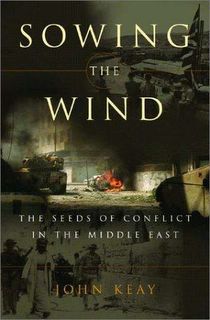Sowing the Wind
by John Keay
by John Keay
Some Big Ellites know that I studied political science in university and i’ve even managed to remember some of it. Professors Ismael and Ross did a remarkable job considering the dope and sleep deprived mind they were dealing with. My main focus was the Middle East. I studied most of the major countries along with their respective presidents, prime ministers, foreign ministers and sheiks. We rarely delved into the people and personalities who actually enforced and implemented the many disastrous policies that have plagued this region for the past 100 years. I basically learned very little about the diplomats, travelers and entrepreneurs who greatly influenced (for better or worse) the modern Middle East.
I received Sowing the Wind by John Keay as a birthday present from the Socialist Redneck. It took me awhile to open it up. I assumed that it would be a mere rehashing of 20th century Middle Easy history. I finally decided to read it because I figured it would be a good way for me to brush up on all of the things I learned so long ago. I have forgotten so since I moved to the Republic of Corruption. I didn’t think it would be such a good introduction to the people who helped shape this troubled region.
Sowing the Wind attempts to chronicle the development of the Middle East from 1900-1960. It starts in 1906 with the so-called Dinshawai incident (or Dinishwai) and ends in 1958 with the coup that toppled the Iranian monarchy. The interesting thing is that Keay doesn’t focus his attention on the major players like Faysal or Nasser. He attempts to paint a broader picture. He looks at people like T.E Lawrence (Lawrence of Arabia) and Kermit Roosevelt(Teddy’s son), the CIA’s lead man in Iraq who played a large role in overthrowing Mossadeq and reinstalling the Shah in 1953. I was enthralled learning about these different people and how their ideologies and personalities affected the region.
You can learn from the title that Keay doesn’t believe that 60 years of Western intervention had much of a positive impact on the region. While this is his main thesis, he makes his claims rather quietly. His incredible research allows the players to do the talking. Keay doesn’t claim to be a historian or a scholar which is one of the reasons this book is such an interesting read. He is an excellent writer. I can’t describe this book as a page turner. It drags on at times and it is easy to get lost in all of the names of the people who impacted the region. Some of the different chapters seem to be carbon copies of others with different names and places cut and pasted in. This may have more to do with the nature of the different British, French and American policies rather than a critique of Keay’s writing. He argues quite convincingly that while the implementation of these imperial policies may have differed their goals were the same, regional hegemony.
Many of the critiques of the book are quite standard. They argue that Keay isn’t evenhanded, that he is anti-Israel and pro-Arab. They argue that his critiques of the British and American policies are not fair. While the results of Franco-Anglo-American policy were devastating, Keay is somehow at fault for not giving any alternatives solutions. My only criticism is that Keay talks a lot about nationalist movements in various countries, especially in the pre and post World War I eras. He also argues that these countries were set up based on imperial designs rather than nationalist lines. I am not sure if one can have nationalist feelings if the nation created was carved out based on an imperialist blueprint.
On the whole this is a very good book and a good read. If you want to learn more about the Middle East in the 20th century pick up this book. I want to send a big shout out to the Socialist Redneck for this excellent book.


No comments:
Post a Comment